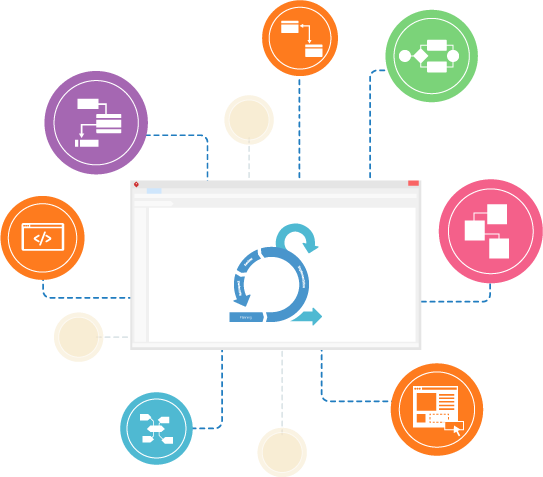On July 7th the Scrum community gathered in Amsterdam (The Netherlands) for the 5th edition of Scrum Day Europe. The goal was to generate insights and define improvements for the Scrum framework from the Scrum community.
During the day we asked everyone to answer 5 questions:
- What has proven to be the strength of Scrum the past 20 years?
- What should be the focus of Scrum the upcoming 20 years?
- What of Scrum frustrated you the most so far?
- What connects you to Scrum?
- What is a small improvement that could be added to Scrum?
Every participant contributed and provided input; thereby it proved to be a true community event!
This years theme was ‘the next iteration’ .Therefore we looked back to see what Scrum brought us the last 20 years, but also looked forward into the future of Scrum. Naturally, the evaluation was done via a retrospective.
What is the Strength of Scrum According to the Participants?
- It’s an easy & lightweight framework (6x)
- It’s a transparency enabler (5x)
- It delivers a framework that leads to sustainable and continuous improvement (4x)
- It appeals to universally basic human needs & values (3x)
- It provides short feedback loops, continuous planning (3x)
- It removes client-supplier boundaries (2x)
- It’s fun and successful (2x)
- It’s an enabler of personal growth
- The usage of time-boxes
- It improves communication on all layers
- It’s not a silver bullet
- It emphasizes multidisciplinary teamwork
What should be the focus of Scrum in the upcoming years according to the Participants?
- Support creating value driven organizations, focus on customer delight (9)
- Enhance the framework for the whole organization (9)
- Keep the simplicity (3)
- Setup processes/gateways before the next sprint can start (2)
- Offer more practices that support scaling Scrum (2)
- Prove with the metrics that Scrum works! (2)
- Keep innovating and adapting
- Deliver working increments
- Address interfacing with non-Scrum organizations
- Setup practices to develop culture
- Embrace the Lean mindset
- Integrate DevOps principles
- Focus on the Sprint Goal
- Offer tools to check the sanity of the product incrementally
- Collaborate with multiple independent organizations
- Offer Scrum for corporate executives
- Apply the Scrum in other “slow development” industries e.g. pharma
- Have more discussion with critics to understand what they feel is missing in Scrum
- Research how much Agile is “Agile”. Because some organizations abuse Agile.
What of Scrum frustrated you the most so far according to the participants?
- Scrum seems so simple, but it is so hard (6)
- The Scrum zombie variant (5)
- Misunderstanding of the Scrum Master role (4)
- Product Owner without mandate (4)
- Management unwilling to change (2)
- Roles require above average people
- Values of Scrum and current organization don’t match
- The pure focus on software development
- Not knowing what to do with portfolio/product management
- The lack of just-do-it
- Working water-scrum-fall
- Team communication
What connects you to Scrum according to the participants?
- Scrum works, start finishing! (5)
- Collaboration addiction (5)
- Awesome work atmosphere (3)
- Invite people to continuously improve, one small step at a time (3)
- I personally got the fun back into my working life! (2)
- Decentralized decision-making (2)
- My 21 years of working in waterfall
- Common senseity of Scrum
- Living it! Using it on work and personally
- Living it! Dealing with unknows
Help to Master Scrum Process with Automated Software
Scrum Process Canvas is a scrum tool built to help you manage your scrum project — from identifying project vision, through to final product delivery making the agile projects much more simple and effective.
Scrum Process canvas helps you to:
- Seamlessly navigate the entire scrum process in a single, beautifully designed scrum process canvas.
- Perform scrum activities quickly, easily and seamlessly. Keep the whole team fully engaged.
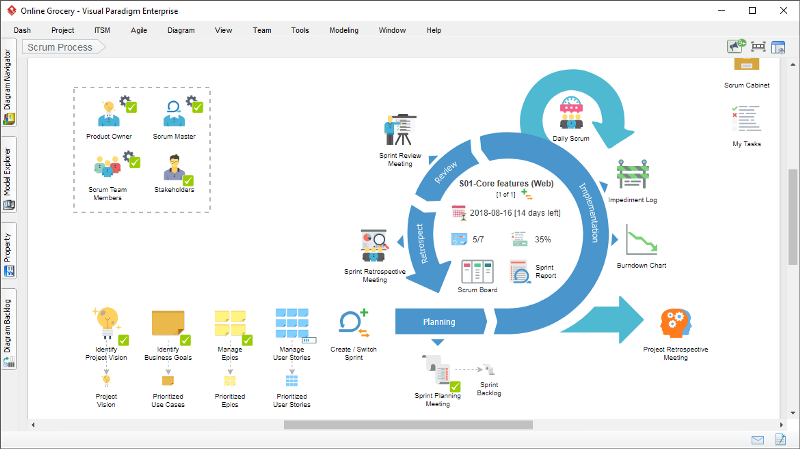
(Open Scrum Process Canvas Quick Tour — Visual Paradigm)
Built for every scrum team.
With a scrum process canvas, scrum work items, agile management tools and intuitive interfaces, Scrum Process Canvas helps your scrum team achieve the greatest success in every scrum project.
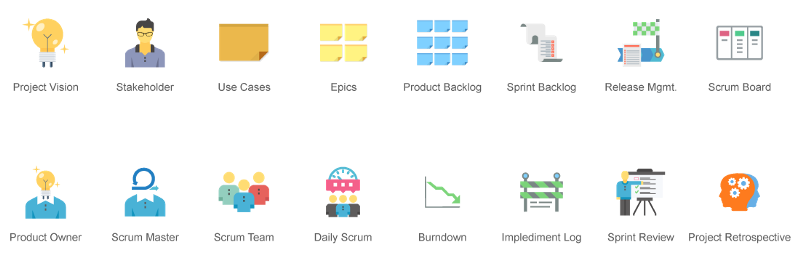
Prioritized product backlog.
Build product backlog incrementally by identifying business goals (as use cases), Epics and user stories. Groom product backlog easily throughout the project.



Organize user stories in User Story Map
- Keep user activities, epics and user stories in a well-structured user story map.
- Easily re-arrange user stories with drag-and-drop.
- Click-to-edit user story.
- Save time and get more done by working from anywhere with web access to the story map.
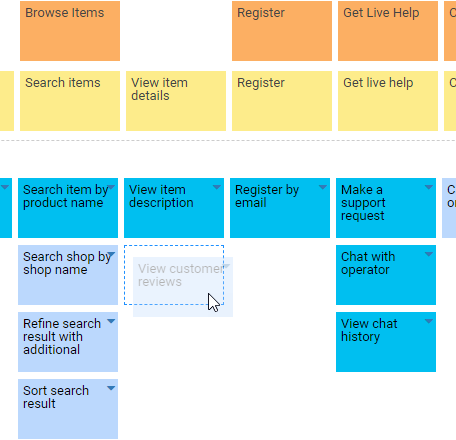
Start a sprint with better planning.
The sprint backlog manager provides an intuitive interface for your agile team to discuss and select stories to be included in a sprint, create and estimate tasks.
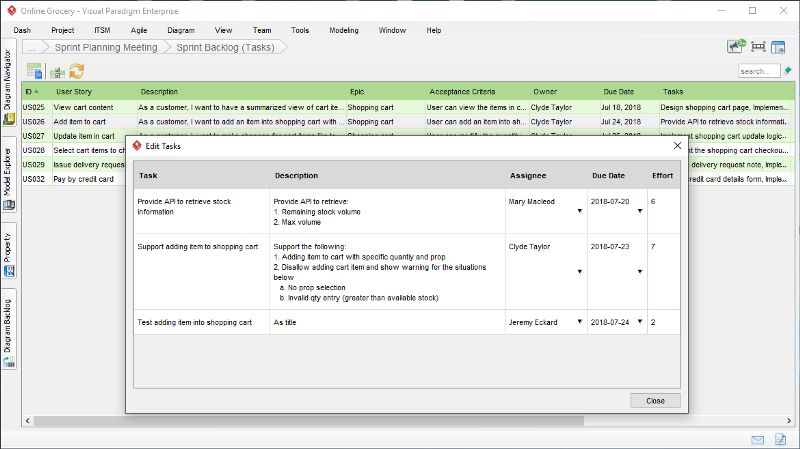
Create Sprint Backlog faster
Quickly include user stories into sprint backlog with the help of the tabular interface and selection tool. The result is a clear list of backlog stories that the entire team can focus on throughout the sprint.
Effort Estimated Task List
Easily maintain a list of development tasks right from the stories included. Accurately estimate the effort involved by comparing tasks, thanks to the list view.
Back your team up for the entire sprint.
All the scrum tools that support your team in turning committed user stories into functional deliverable throughout a sprint.






Record the daily scrum meeting
- Keep records for the works done, works planned and impediments encountered reported by each team member in every daily scrum meeting.
- Create tasks to manage the action items identified in a daily scrum meeting.
- Easily retrieve the content of an earlier daily scrum meeting.
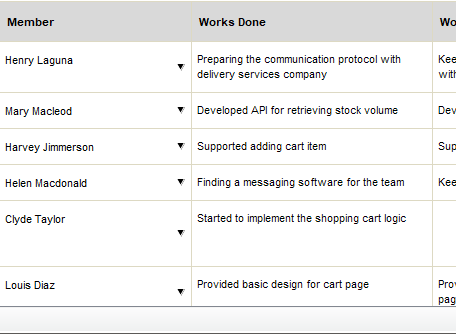
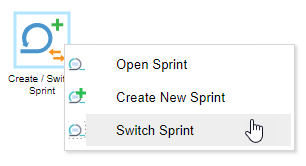
Iterate seamlessly.
Perform sprint activities for one sprint at one time. Easily switch to any earlier sprint to review its history at any time.
Agile release management.
With user story map, you can easily add and arrange stories into release partitions at anytime. Status of project deliverables can also be updated in ad-hoc manner.



Release management with ease
- The user story map provides a visual approach to release management. As part of release planning, you can add user stories into releases through drag and drop.
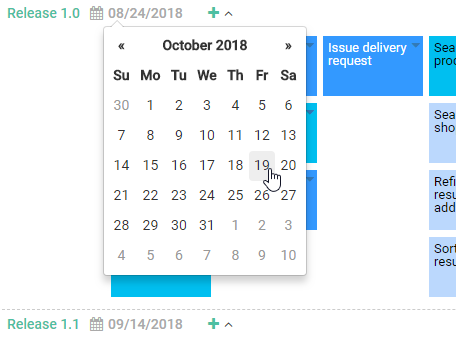
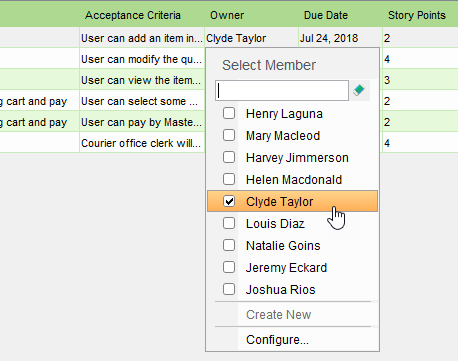
Bring everyone on the same page.
Effectively manage the roles and responsibilities of team members. Bring scrum master, product owner, business analysts, UXers and developers on the same page right from the start.
Instant documentation, auto archived.
Generate reports for product backlog, sprint backlog, task list, various meetings and more. Retrieve documents from a visual scrum cabinet.
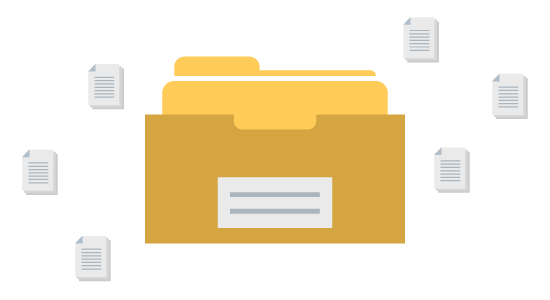
Built-in task management platform.
The one-stop agile solution provides seamless integration between backlog and task management. You can create tasks, report and monitor progress’ all in one place.
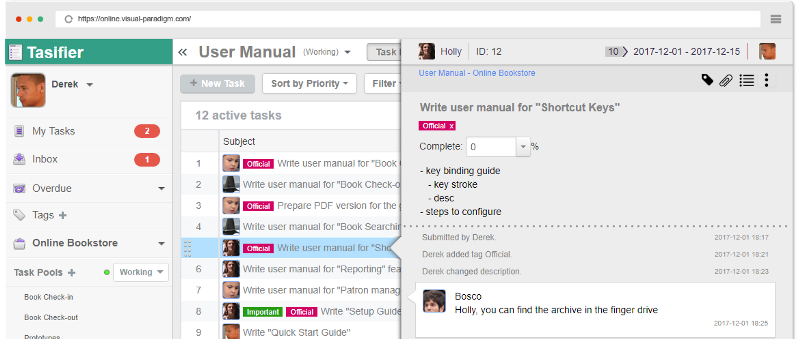
Single software, multiple purposes.
Power up your scrum project with UML, BPMN, ERD, DFD, UX (wireframe, prototyping), code engineering, ORM, mind mapping and more.
